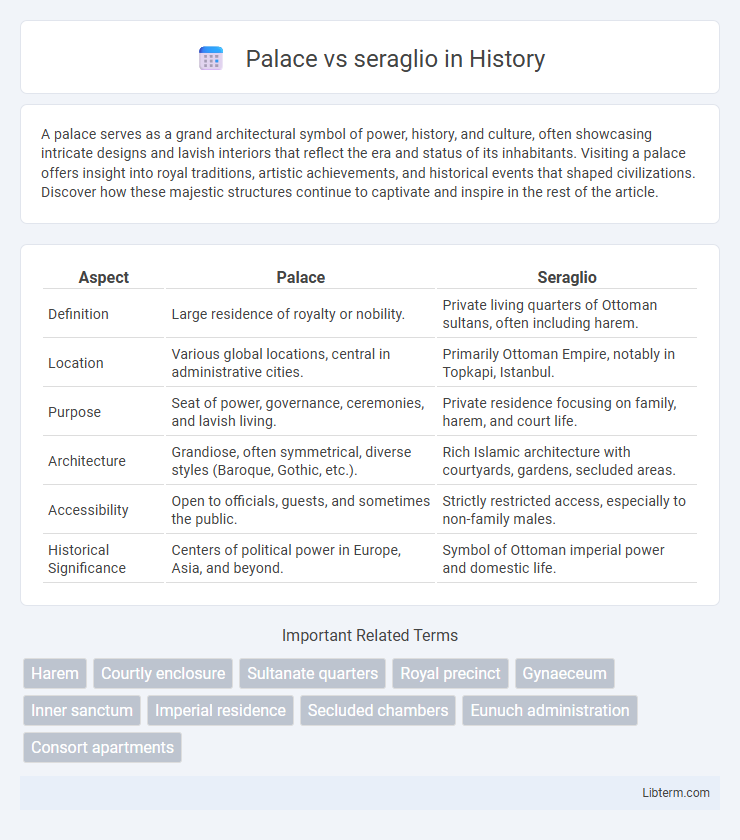A palace serves as a grand architectural symbol of power, history, and culture, often showcasing intricate designs and lavish interiors that reflect the era and status of its inhabitants. Visiting a palace offers insight into royal traditions, artistic achievements, and historical events that shaped civilizations. Discover how these majestic structures continue to captivate and inspire in the rest of the article.
Table of Comparison
| Aspect | Palace | Seraglio |
|---|---|---|
| Definition | Large residence of royalty or nobility. | Private living quarters of Ottoman sultans, often including harem. |
| Location | Various global locations, central in administrative cities. | Primarily Ottoman Empire, notably in Topkapi, Istanbul. |
| Purpose | Seat of power, governance, ceremonies, and lavish living. | Private residence focusing on family, harem, and court life. |
| Architecture | Grandiose, often symmetrical, diverse styles (Baroque, Gothic, etc.). | Rich Islamic architecture with courtyards, gardens, secluded areas. |
| Accessibility | Open to officials, guests, and sometimes the public. | Strictly restricted access, especially to non-family males. |
| Historical Significance | Centers of political power in Europe, Asia, and beyond. | Symbol of Ottoman imperial power and domestic life. |
Introduction to Palaces and Seraglios
Palaces are grand, fortified residences historically designed for royalty and nobility, characterized by expansive architecture and elaborate decoration symbolizing power and wealth. Seraglios, specifically used in the Ottoman context, refer to the secluded living quarters within or adjacent to a palace, traditionally reserved for the sultan's harem and female members of the court. These distinct spaces highlight the cultural and functional divisions within royal complexes, emphasizing privacy and social hierarchy in palace design.
Historical Origins of Palaces and Seraglios
Palaces originated as grand residences for monarchs and nobility, symbolizing political power and architectural grandeur across cultures. Seraglios, notably in Ottoman society, referred to the secluded living quarters within royal palaces reserved for the sultan's family and concubines, reflecting social structures and cultural norms of privacy. The distinction between palaces and seraglios highlights differing historical functions, with palaces serving as administrative centers and seraglios as private domestic spaces.
Architectural Features: Palace vs Seraglio
Palaces typically feature expansive layouts with grand facades, symmetrical designs, and multiple wings designed for state functions and residential purposes, emphasizing luxury and formal representation. Seraglios, particularly in Ottoman architecture, are characterized by secluded courtyards, high walls, intricate tile work, and private quarters arranged to ensure privacy and security for the ruler's family. The architectural distinction lies in palaces favoring openness and display, while seraglios prioritize seclusion and intricate internal spatial organization.
Social and Political Functions
Palaces served as grand residences for monarchs or high-ranking nobility, symbolizing political power and social hierarchy through their opulent architecture and ceremonial spaces designed for official state functions. The seraglio, traditionally a secluded part of a palace in Ottoman culture, functioned as a private domestic space housing the ruler's family and concubines, reflecting social norms around gender segregation and dynastic control. Both structures reinforced social stratification and governance by physically segregating public political authority from private familial and domestic life.
Cultural Symbolism and Representation
Palaces symbolize centralized political power and social hierarchy, reflecting a ruler's authority and the state's grandeur through grand architecture and opulent design. Seraglios, often serving as private living quarters within palaces, represent cultural notions of privacy, gender segregation, and domestic space, especially in Ottoman and Islamic contexts. The distinction between palace and seraglio highlights differing cultural values around public display versus private seclusion in historical power structures.
Daily Life Within Palaces and Seraglios
Daily life within palaces and seraglios reflected distinct social structures and cultural practices. In palaces, monarchs and their courtiers engaged in governance, ceremonial events, and diplomatic receptions, emphasizing political power and luxury. Seraglios, especially within Ottoman contexts, functioned as secluded quarters where women of the royal family and concubines lived under strict hierarchical and social rules, focusing on privacy, service, and the management of domestic affairs.
Influence on Literature and Art
The Palace and the Seraglio have profoundly influenced literature and art by inspiring lavish depictions of opulence, power, and exoticism in works from the Renaissance to modern times. The Palace, often symbolizing state authority and classical grandeur, appears in epic poems and historical paintings, while the Seraglio, representing the mystique of the Ottoman harem, permeates orientalist literature and romanticized Oriental art. These contrasting settings have fueled narrative themes of intrigue, cultural encounter, and forbidden desires, shaping artistic expression across diverse media.
Regional Variations and Examples
Palaces and seraglios exhibit significant regional variations shaped by cultural, architectural, and functional differences. In Ottoman architecture, the Topkapi Palace's seraglio functioned as a secluded women's quarter with strict privacy, while Persian palaces like the Golestan featured grand reception halls and gardens prioritizing royal ceremonies. European palaces, such as Versailles, emphasized vast spaces and public state rooms, contrasting with seraglios' exclusive, private living areas, highlighting diverse approaches to royal residence design across regions.
Preservation and Modern Interpretations
Palaces and seraglios represent distinct architectural and cultural heritages, with preservation efforts emphasizing their unique historical contexts. Conservation techniques for palaces often involve maintaining grandiose elements and expansive grounds, while seraglios require delicate restoration of intricate interior details reflecting Ottoman social structures. Modern interpretations use digital reconstructions and virtual tours to enhance public engagement and educational outreach, ensuring these historic sites remain accessible and relevant today.
Conclusion: Comparing Palace and Seraglio
A palace serves as a grand royal residence emphasizing architectural magnificence, administrative functions, and public state affairs, while a seraglio specifically refers to the secluded private quarters of women in Ottoman or Muslim royal households, highlighting domestic and gender-segregated space. Palaces are typically characterized by expansive courtyards, ceremonial halls, and offices, reflecting political power and cultural heritage, whereas seraglios function as exclusive living spaces that ensure privacy and security for the royal family members. Understanding the distinct cultural, architectural, and functional roles between palaces and seraglios underscores their unique contributions to historical royal life and governance.
Palace Infographic

 libterm.com
libterm.com